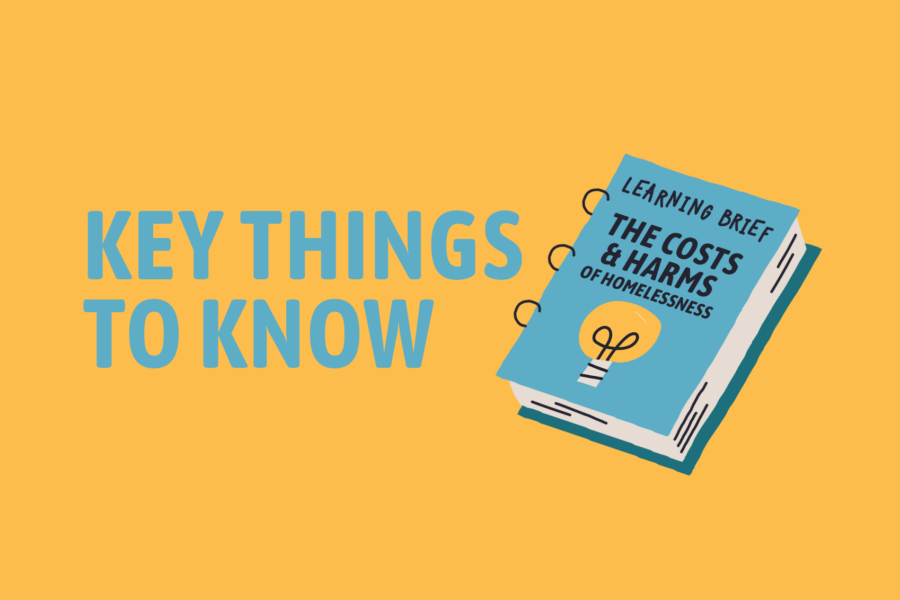Homelessness reflects some of the most irreparable harms being borne by individuals, communities, and our society at large. The costs associated with homelessness are multidimensional, spanning social, medical, behavioral, economic, and moral concerns.
Evidence demonstrates that effective solutions to homelessness can lead to significant savings across sectors such as health care, criminal justice, and emergency systems. But the moral imperative to address homelessness transcends any cost-benefit approach. That being said, understanding what is at stake can help support urgency and action.
Community Solutions has produced a comprehensive brief to offer a deeper understanding of the wide-ranging costs and consequences of homelessness. Here we have compiled some of the most important things to know from that brief.
Costs to Individuals
Homelessness can adversely affect virtually every aspect of a person’s life, from one’s sense of safety and social support to overall health and life expectancy. People experiencing homelessness experience elevated rates of dangerous health conditions and violent victimization. Daily stressors, like ensuring personal safety and finding a place to sleep, coupled with the instability and trauma of being unhoused, can also increase a person’s vulnerability to psychological conditions, distress, and substance use disorders.
People experiencing homelessness have significantly higher rates of mortality and reduced life expectancies.
Adults experiencing homelessness in the U.S. have a mortality rate 3.5 higher than the housed population, and a life expectancy that is at least 26 years shorter than the national average.
The rates of several chronic conditions and risks of infectious diseases are significantly higher among people with a history of homelessness.
For instance, tuberculosis is about 46 times more common, and hepatitis C virus infections are four times more prevalent in the population experiencing homelessness in the U.S. than the general population.
Individuals experiencing homelessness are disproportionately likely to experience a traumatic brain injury in their lifetime.
Nearly one in four people experiencing homelessness suffer from a moderate to severe traumatic brain injury in their lifetime, making them 10 times more likely to experience such an injury than the general population. Assault was the most common cause, which points to a heightened risk of experiencing physical violence.
Rates of violent victimization are alarmingly high among people experiencing homelessness.
A study conducted in 5 U.S. cities found that nearly half of those experiencing homelessness had been victims of violent attacks.
Costs to Children and Families
For children and families, homelessness can lead to devastating consequences, including developmental delays, disruptions in education, and family separation. Infants born during a period of unstable housing resulting in homelessness have higher rates of low birthweight, respiratory problems, and fever than infants born to housed, low-income families.
Repeated exposure to stressful and traumatic events at a young age causes severe emotional distress, resulting in a high incidence of mental health challenges for children experiencing homelessness.
One study found that 24% to 40% of school-age children experiencing homelessness in the U.S. have mental health issues requiring clinical evaluation, which is a rate 2 to 4 times greater than that reported for low-income children of the same age.
Homelessness also disrupts children and youth’s schooling, from elementary school to higher education, limiting opportunities to advance their education and economic standing.
Research conducted in New York City found that missing 20 days or more in a school year is twice as common among elementary school students experiencing homelessness, placing them at greater risk of being held back and dropping out of school. In turn, youth who did not complete high school were 4.5 times more likely to experience homelessness than peers who completed their high school diploma or GED.
Costs to Communities and Systems
Without the stability of secure housing needed to appropriately address the higher burden of comprehensive and complex needs outlined above, individuals experiencing homelessness use and interact with mainstream service systems — like child welfare, hospitals and emergency health care services, criminal justice, and income support — to a greater extent than stably housed community members. In addition, the federal government and nonprofit service providers make significant investments in temporary emergency housing, which serves just half of the adult population experiencing homelessness and is often a costly alternative to permanent housing.
Homeless program costs are often far greater than the cost of providing rental assistance.
A study examining the costs of homeless and other systems serving people experiencing homelessness for the first time across six communities found that longer stays in a homeless program resulted in escalating costs that were much greater than rental subsidies based on Fair Market Rents for the same time period.
People experiencing homelessness visit Emergency Departments at higher rates than the overall population and have longer average hospital stays.
Compared to stably housed individuals, people experiencing homelessness have roughly three times as many visits to Emergency Departments each year.
Laws that criminalize homelessness are highly costly.
For example, over the course of 2016 and 2017, Boulder, Colorado spent at least $1.8 million annually enforcing anti-homeless ordinances. In LA, the police department spent anywhere from $53.6 million to $87.3 million in one year on interactions with people experiencing homelessness.
Cleaning up encampments can strain city budgets.
Rising rates of unsheltered homelessness are correlated with an increase in the number of reported encampments. Unfortunately, cities often respond to encampments by clearing and closing them, which can further displace individuals and lead to harmful consequences. Responding to encampments in this way is also resource-intensive for local governments. For example, a 2019 study found that responding to homeless encampments cost Houston, Chicago and Tacoma an average of around $3.5 million in a single year.
Costs to Society
The harms of homelessness result in profound costs to society at both national and global scales. Persistent and increasing homelessness provides a stark reflection of systemic socioeconomic inequality in the United States – one of the richest countries in the world, yet where income and wealth inequality is greater than almost any other developed nation.
Local income inequality plays a critical role in producing homelessness in communities across the U.S.
An analysis of changes in income inequality, homelessness, renter cost burden, and home values over time found that an increase in income inequality within a community generates higher rates of homelessness.
Centuries of systemic and structural racism have generated conditions for racial disparities in homelessness in the U.S.
Historic and ongoing barriers to economic security and progress – including land theft, segregation, redlining, and present-day institutional practices – have led to an overrepresentation of Black, Indigenous, and Latinx people among the population living in poverty and those experiencing homelessness.
Due to ableist policies and structures, individuals with disabilities face substantial barriers to employment and housing, as well as disparities in income, poverty rates, and homelessness.
In 2021, 57% of adults living in shelters reported a disability, although individuals with disabilities comprise 13% of the civilian noninstitutionalized population.
On a global scale, homelessness is a profound human rights crisis.
Every year, homelessness contributes to countless premature deaths, indicating a failure to protect the most basic right to life.




